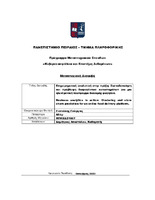Επιχειρηματική αναλυτική στην πράξη : συσταδοποίηση και πρόβλεψη διαφυγόντων καταστημάτων για μια ηλεκτρονική πλατφόρμα διανομής φαγητού
Business analytics in action : clustering and store churn prediction for an online food delivery platform

Προβολή/
Λέξεις κλειδιά
Business analytics ; Data science ; Churn prediction ; Customer segmentation ; Decision tree model ; Logistic regression ; Marketplace platform ; Food delivery business ; Business intelligenceΠερίληψη
Η παρούσα διατριβή εμβαθύνει στους τομείς της Επιχειρηματικής Αναλυτικής (Business Analytics, BA) και της Επιχειρηματικής Ευφυΐας (Business Intelligence, BI) με έμφαση στην εφαρμογή πελατειακών αναλυτικών τεχνικών (Customer Analytics, CA) και τεχνικών μηχανικής μάθησης (Machine Learning, ML). Ο στόχος είναι να αναλυθούν τα πλεονεκτήματα, οι προκλήσεις και οι τεχνικές που σχετίζονται με τα BA και CA, διερευνώντας παράλληλα τις πρακτικές εφαρμογές της συσταδοποίησης καταστημάτων/πελατών και την πρόβλεψη των διαφυγόντων πελατών.
Το Κεφάλαιο 1 χρησιμεύει ως εισαγωγή, παρέχοντας μια επισκόπηση της έρευνας που θα ακολουθήσει. Επίσης περιγράφει τον σκοπό της εργασίας, ο οποίος είναι η διερεύνηση του πεδίου των BA/BI και των εφαρμογών τους, και πιο συγκεκριμένα στο πλαίσιο του CA. Το κεφάλαιο ολοκληρώνεται με μια σύντομη περιγραφή της δομής της διατριβής.
Το Κεφάλαιο 2 εμβαθύνει στις βασικές αρχές του BA και του BI. Ξεκινάμε εισάγοντας την Επιχειρηματική Ανάλυση, συζητώντας τις μεθοδολογίες της και διερευνούμε διάφορες προοπτικές εντός του πεδίου. Στη συνέχεια του κεφαλαίου, ορίζουμε την Επιχειρηματική Ευφυΐα, τονίζοντας τη σημασία της στην κατάληξη και λήψη τεκμηριωμένων αποφάσεων. Επιπλέον, εξετάζονται η ιστορική εξέλιξη και οι διακρίσεις μεταξύ BA και BI. Καταλήγοντας, διερευνούμε τη δημιουργία επιχειρηματικής αξίας και προσδιορίζουμε τις τρέχουσες τάσεις ανάπτυξης στους τομείς BA/BI.
Εν συνεχεία, το Κεφάλαιο 3 εστιάζει συγκεκριμένα στη ΒΑ. Εδώ θα διερευνηθούν διαφορετικές μέθοδοι ΒΑ, επισημαίνοντας τα πλεονεκτήματα και τις προκλήσεις τους. Στο παρών κεφάλαιο θα αναπτυχθούν επίσης τα διάφορα πεδία εφαρμογής του BA και θα παρουσιαστούν διάφορες παραλλαγές εφαρμογών εντός του τομέα. Τέλος, θα αναφερθούμε σε διαφορετικούς τύπους ΒΑ, συμπεριλαμβανομένων των περιγραφικών αναλυτικών, διαγνωστικών αναλυτικών, προγνωστικών αναλυτικών και καθοδηγητικών αναλυτικών.
Στο Κεφάλαιο 4 αναπτύσσεται το Customer Analytics, διαμορφώνοντας το πλαίσιο της ανάπτυξής του στον κλάδο του ηλεκτρονικού εμπορίου. Εδώ θα μελετήσουμε διαφορετικά μοντέλα αγοράς, τους τύπους και τις διαφορές τους. Στη συνέχεια, θα ανατρέξουμε στην ιστορική εξέλιξη του CA και θα απασχοληθούμε με τα πλεονεκτήματα και τις τεχνικές του. Ιδιαίτερη προσοχή δίνεται στην τεχνική της συσταδοποίησης (Clustering), με μια λεπτομερή εξέταση διαφόρων μορφών όπως η συσταδοποίηση με βάση την κατανομή, η συσταδοποίηση με βάση την πυκνότητα, η ιεραρχική συσταδοποίηση και η κεντροειδής συσταδοποίηση. Επιπλέον, το κεφάλαιο διερευνά την ανακάλυψη προτύπων και την πρόβλεψη των πελατών που έχουν αποχωρήσει από το ενεργό πελατολόγιο.
Το Κεφάλαιο 5 χρησιμεύει ως το πρακτικό μέρος της διατριβής. Ξεκινά με μια εισαγωγή στα εργαλεία υλοποίησης που χρησιμοποιούνται για την εργασία. Στη συνέχεια, το κεφάλαιο εστιάζει στην προετοιμασία δεδομένων, συμπεριλαμβανομένης της ανάγνωσης δεδομένων, του καθαρισμού/οργάνωσης και της διερευνητικής ανάλυσης των δεδομένων (Exploratory Data Analysis, EDA). Στη συνέχεια, παρουσιάζεται το μοντέλο συσταδοποίησης που εφαρμόστηκε και συνεχίζουμε με την προσπάθεια για πρόβλεψη των διαφυγόντων πελατών (Churn Prediction), χρησιμοποιώντας τεχνικές όπως τα Δέντρα Αποφάσεων (Decision Trees) και της Λογιστικής Παλινδρόμησης (Logistic Regression). Τέλος, το κεφάλαιο ολοκληρώνεται με επιχειρηματικές προτάσεις που προκύπτουν από τα αναλυτικά ευρήματα μας.
Συνολικά, αυτή η διατριβή παρέχει μια ολοκληρωμένη εξερεύνηση των BA, BI και CA, με ειδική εστίαση στη συσταδοποίηση καταστημάτων/πελατών και στην πρόβλεψη των διαφυγόντων πελατών. Συνδυάζοντας θεωρητική ανάλυση και πρακτική εφαρμογή, συμβάλλει στην κατανόηση αυτών των τομέων και προσφέρει πολύτιμες γνώσεις για τις επιχειρήσεις που επιδιώκουν να αξιοποιήσουν τη λήψη αποφάσεων βάσει δεδομένων.


